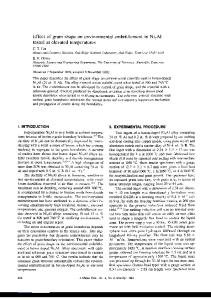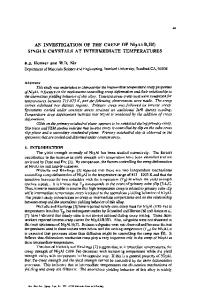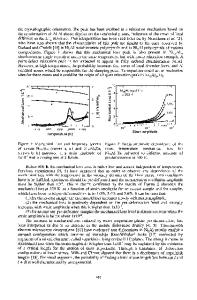Environmental embrittlement of boron-doped Ni 3 (Al, Ti) single crystals at room temperature
- PDF / 1,939,064 Bytes
- 9 Pages / 576 x 792 pts Page_size
- 51 Downloads / 463 Views
Environmental embrittlement of Ll 2 -type Ni3(Al, Ti) single crystals doped with 0.05 mass % boron was investigated at room temperature as functions of environmental media and strain rate. Environmental embrittlement occurs in air, water, and hydrogen gas, and is also very sensitive to strain rate with a decrease of elongation with decreasing strain rate. Environmental embrittlement is little influenced by boron doping, indicating no strong interaction with hydrogen in lattice. In embrittled condition, tensile elongation and fracture stress are reduced, and fracture mode is primarily {001} cracking with a river pattern. Based on these results, it is proposed that hydrogen affects lattice bonding and thereby reduces the cohesion strength on {001} atomic plane. Also, it is suggested that the major cause of environmental embrittlement of boron-doped Ni3(Al, Ti) single crystals is due to the reaction of water (i.e., H 2 O) in environment with the reactive element of Al (and/or Ti) and of H 2 in environment with the surface reactive element of Ni.
I. INTRODUCTION In L l 2 alloys possessing very attractive high temperature structural properties, it has been shown that significant environmental embrittlement occurs in single crystalline form,1"3 as well as in poly crystalline form4"6 at ambient temperatures. These alloys were embrittled in ordinary air or hydrogen gas at ambient temperatures at the conventional deformation rate. Poly crystals were embrittled by promoting grain boundary fracture4"6 while single crystals were embrittled by introducing lattice cleavage cracking.1"3 To develop Ll 2 -ordered intermetallics as structural materials, understanding and control (or suppression) of environmental embrittlement is an urgent subject. Also, it has been demonstrated by recent studies that low ductility and brittle fracture of most ordered intermetallics at ambient temperatures are not due to an intrinsic factor, i.e., inherently brittle, but due to an extrinsic factor such as environmental embrittlement.7'8 To ensure this demonstration, a study using single crystals is a very useful method because they possess simple microstructure and a simple loading system and, therefore, allow fundamental understanding of environmental embrittlement. In a previous study,2 Ni3(Al, Ti) single crystals showed significant embrittlement in environment such as air and hydrogen gas. On the other hand, some experimental results that environmental embrittlement is suppressed by the addition of a trace amount of boron (and also carbon) have been found in the polycrystalline form of Ni3Al,9 Ni 3 (Si,Ti), 10 ' u and Ni 3 Si. 12 Therefore, to know whether boron addition is effective in suppressing environmental embrittlement 2534 http://journals.cambridge.org
J. Mater. Res., Vol. 8, No. 10, Oct 1993 Downloaded: 13 Apr 2015
in the single crystalline form of Ni3(Al, Ti) is very interesting. In this study, environmental embrittlement of boron-doped Ni 3 (Al,Ti) single crystals at room temperature is characterized by the tensile test and resultant
Data Loading...











